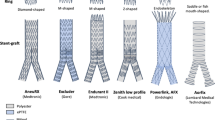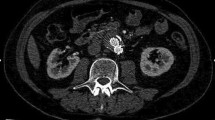Abstract
Endovascular repair (EVAR) is playing an increasingly role in the treatment of abdominal aortic aneurysm. A successful procedure depends on the complete sealing of the aneurysm sac from blood flow to achieve general pressure relief and avoid aneurysm rupture, with a shrinkage of the aneurysm sac. The most common complication of EVAR is endoleak that is the persistence of perigraft flow within the aneurysm sac, which has to be considered the major cause of enlargement and rupture of the aneurysm, and the main indication for surgical late conversion. For this reason, strict surveillance of these patients is mandatory for the early detection of endoleaks and the preferred method of follow-up is represented by CT angiography. However, CTA has limitations. The investigation is repeated several times, making radiation exposure a necessary concern. Therefore, it would be useful to have another reliable diagnostic examination during follow-up. Color duplex ultrasound is non-invasive, does not use radiation or contrast medium, is less expensive, easy to perform and widely available. However, this technique obtained poor results in terms of sensitivity in the detection of endoleaks. In the last years, the introduction of ultrasound contrast agents and contrast-specific imaging has, however, rekindled interest in this modality and its potential for replacing of CTA in routine surveillance. The purpose of this review is to highlight the diagnostic value of CEUS in the post-EVAR endoleaks detection.









Similar content being viewed by others
References
Bush RL, Lumsden AB, Dodson TF, et al. Mid-term results after endovascular repair of abdominal aortic aneurysm. J Vasc Surg 2001;33(2 Suppl):S70-76.
May J, White GH, Waugh R, et al. Comparison of first- and second-generation prostheses for endoluminal repair of abdominal aortic aneurysms: a 6-year study with life table analysis. J Vasc Surg 2000;32:124-129.
Zarins CK, White RA, Hodgson KJ, Schwarten D, Fogarty TJ. Endoleak as a predictor of outcome after endovascular aneurysm repair: AneuRx multicenter clinical trial. J Vasc Surg 2000;32:90-107.
Cuypers P, Buth J, Harris PL, Gevers E, Lahey R. Realistic expectations for patients with stent-graft treatment of abdominal aortic aneurysms. Results of a European multicentre registry. Eur J Vasc Endovasc Surg 1999; 17: 507–516.
Gilling-Smith G, Brennan J, Harris P, et al. Endotension after endovascular aneurysm repair: definition, classification, and strategies for surveillance and intervention. J Endovasc Surg 1999; 6: 305–307.
Golzarian J, Struyven J, Abada HT et al. Endovascular aortic stent-grafts: transcatheter embolization of persistent perigraft leaks. Radiology 1997; 202: 731–734.
Gorich J, Rilinger N, Sokiranski R et al. Leakages after endovascular repair of aortic aneurysms: classification based on findings at CT, angiography, and radiography. Radiology 1999; 213: 767–772.
Lumsden AB, Allen RC, Chaikof EL, et al. Delayed rupture of aortic aneurysms following endovascular stent grafting. Am J Surg 1995; 170: 174–178.
Vallabhaneni SR, Harris PL. Lessons learnt from the EUROSTAR registry on endovascular repair of abdominal aneurysm repair. Eur J Radiol 2001; 39: 34–41.
Bown M.J. Fishwick G, et al. (2004) The postoperative complications of endovascular aortic aneurysm repair. J Cardiovascular Surg 45:335-47.
Golzarian J, Dussaussois L, Abada HT, et al. Helical CT of aorta after endoluminal stent-graft therapy: value of biphasic acquisition. AJR Am J Roentgenol 1998;171:329-331.
Brenner DJ, Hall EJ. Computer Tomography – An increasing Source of Radiation Exposure. N Engl J Med 2007; 357(22): 2277-84.
Raman KG, Missig-Carrol N, Richardson T, Muluk SC, Makaroun MS. Color-flow duplex ultrasound versus computed tomographic scan in the surveillance of endovascular aneurysm repair. J Vasc Surg 2003;38:645-51.
Sato DT, Goff CD, Gregory RT, et al. Endoleak after aortic stent graft repair: diagnosis by color duplex ultrasound scan versus computed tomography scan. J Vasc Surg 1998;28:657-663.
Henao EA, Hodge MD, Felkai DD, et al. Contrast-enhanced duplex surveillance after endovascular abdominal aortic aneurysm repair: improved efficacy using a continuous infusion technique. J Vasc Surg 2006;43:259-264.
Bargellini I, Napoli V, Petruzzi P, et al. Type II lumbar endoleaks: hemodynamic differentiation by contrast-enhanced ultrasound scanning and influence on aneurysm enlargement after endovascular aneurysm repair. J Vasc Surg 2005;41:10-18.
Napoli V, Bargellini I, Sardella SG, et al. Abdominal aortic aneurysm: contrast-enhanced US for missed endoleaks after endoluminal repair. Radiology 2004;233:217-225.
Giannoni MF, Palombo G, Sbarigia E, et al. Contrast-enhanced ultrasound imaging for aortic stent-graft surveillance. J Endovasc Ther 2003;10:208-217.
Bendick PJ, Bove PG, Long GW, et al. Efficacy of ultrasound scan contrast agents in the noninvasive follow-up of aortic stent grafts. J Vasc Surg 2003;37(2):381-385.
Wei K, Skyba DM, Firschke C, et al. Interactions between microbubbles and ultrasound: in vitro and in vivo observations. J Am Coll Cardiol.1997; 29(5):1081-8.
McWilliams RG, Martin JM, White D, et al. Detection of endoleak with enhanced ultrasound imaging: comparison with biphasic computed tomography. J Endovasc Ther 2002;9:170-179.
McWilliams RG, Martin JM, White D, et al. Use of contrast-enhanced ultrasound in follow-up after endovascular aortic aneurysm repair. J Vasc Interv Radiol 1999;10:1107-1114.
Greis C. Technology overview: SonoVue (Bracco, Milan). Eur Radiol Suppl (2004) 14[suppl 8]:P11–P15.
Brannigan M, Burns PN, Wilson SR. Blood flow patterns in focal liver lesions at microbubble-enhanced US. Radiographics. 2004;24(4):921–935.
Dill-Macky MJ, Burns PN, Khalili K, et al. Focal hepatic masses: enhancement patterns with SHU 508A and pulse-inversion US. Radiology 2002;222:95–102.
Wilson SR, Burns PN. Liver mass evaluation with ultrasound: the impact of microbubble contrast agents and pulse inversion imaging. Semin Liver Dis. 2001;21(2):147–159.
Iezzi R, Basilico R, Giancristofaro D, et al. Contrast-enhanced ultrasound versus color duplex ultrasound imaging in the follow-up of patients after endovascular abdominal aortic aneurysm repair. J Vasc Surg. 2009;49(3):552-60.
Dill-Macky MJ, Wilson SR, Sternbach Y, Kachura J, Lindsay T. Detecting endoleaks in aortic endografts using contrast-enhanced sonography. AJR Am J Roentgenol. 2007;188(3):W262-8.
Giannoni MF, Fanelli F, Citone M, et al. Contrast ultrasound imaging: the best method to detect type II endoleak during endovascular aneurysm repair follow-up. Interact Cardiovasc Thorac Surg 2007;6:359-362.
Carrafiello G, Laganà D, Recaldini C, et al. Comparison of contrast-enhanced ultrasound and computed tomography in classifying endoleaks after endovascular treatment of abdominal aorta aneurysms: preliminary experience. Cardiovasc Intervent Radiol 2006;29:969-974.
White GH, Yu W, May J, Chaufour X, Stephen MS. Endoleak as a complication of endoluminal grafting of abdominal aortic aneurysms: classification, incidence, diagnosis, and management. J Endovasc Surg 1997;4:152-168.
White GH, May J, Waugh RC, Chaufour X, Yu W. Type III and type IV endoleak: toward a complete definition of blood flow in the sac after endoluminal AAA repair. J Endovasc Surg 1998;5:305-309.
White GH, May J, Petrasek P, et al. Endotension: an explanation for continued AAA growth after successful endoluminal repair. J Endovasc Surg 1999;6:308-315.
Author information
Authors and Affiliations
Corresponding author
Rights and permissions
About this article
Cite this article
Iezzi, R., Cotroneo, A.R., Basilico, R. et al. Endoleaks after endovascular repair of abdominal aortic aneurysm: value of CEUS. Abdom Imaging 35, 106–114 (2010). https://doi.org/10.1007/s00261-009-9526-7
Received:
Accepted:
Published:
Issue Date:
DOI: https://doi.org/10.1007/s00261-009-9526-7




